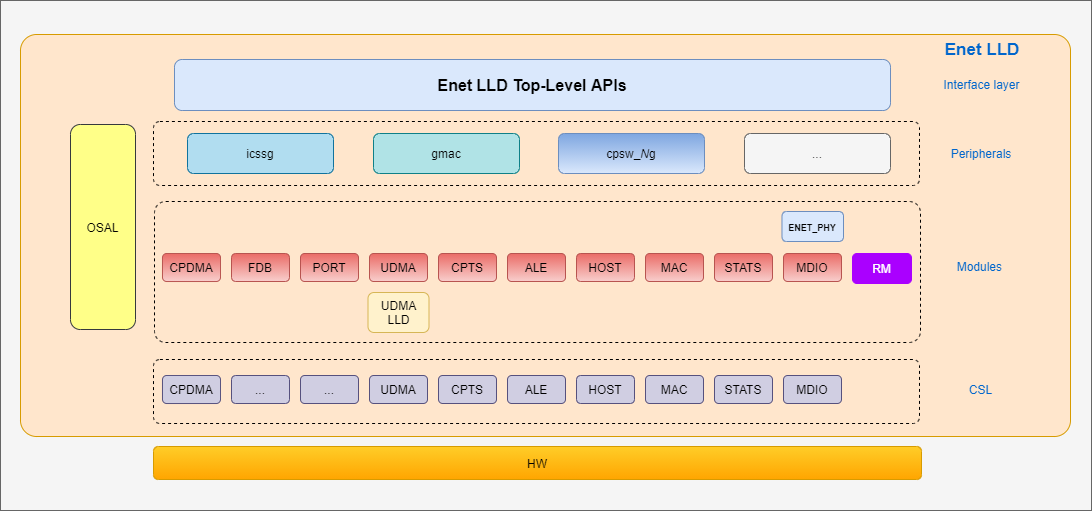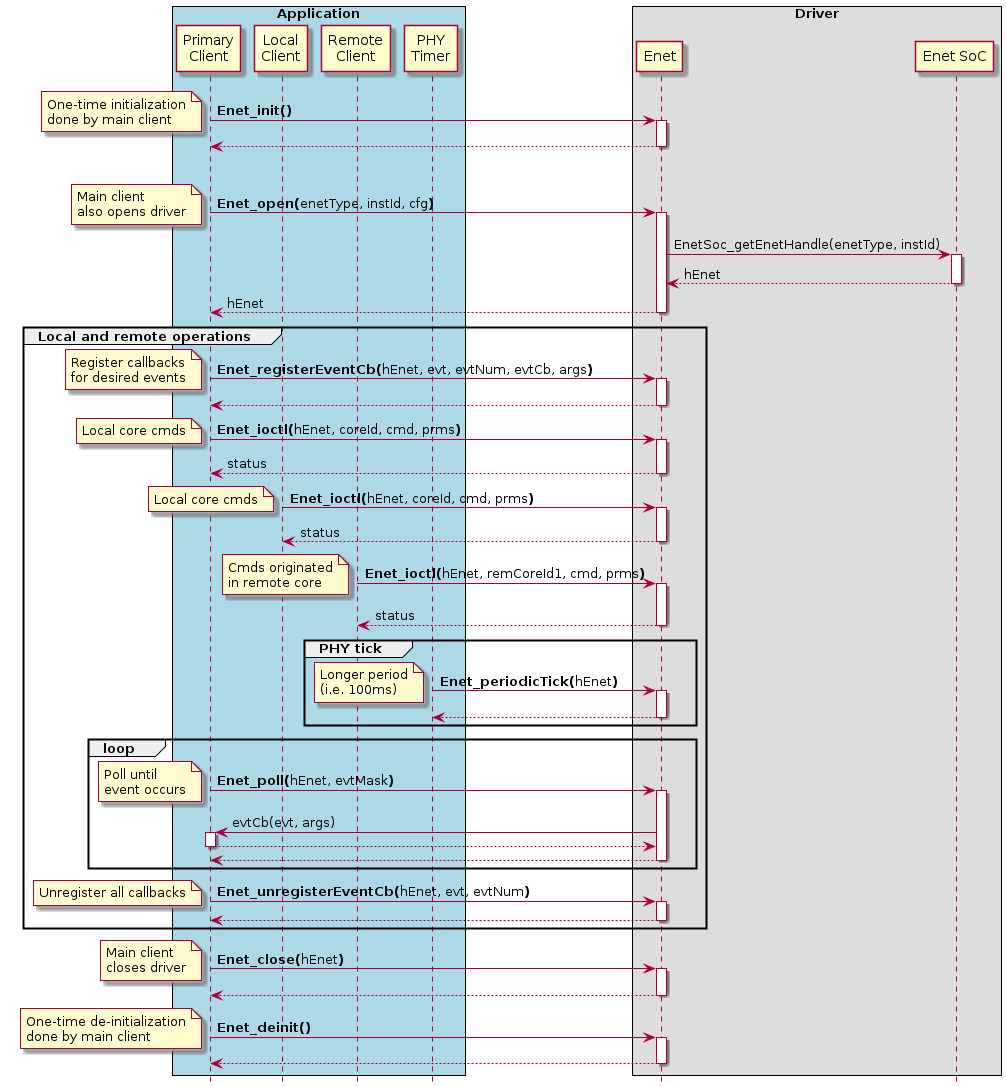The Unified Ethernet Low-Level Driver (Enet LLD) is a driver that aims at providing an unified interface for the different Ethernet peripherals found in TI SoCs.
The Enet LLD is composed of the following layers: top-layer APIs, peripheral layer, module layer and CSL. The diagram below depicts the layers in the Enet LLD.

The Enet LLD provides two sets of APIs: control and DMA.
The control API is an IOCTL-based interface which is used by applications to control the Ethernet peripheral and its submodules.
For further details on the top-level control APIs, refer to the Enet Main API.
The DMA API is used by applications to perform data movement related operations, such as opening and closing DMA channels, submitting and retrieving packets from the underlying DMA controller.
For further details on the top-level control APIs, refer to the Enet Data Path (DMA).
The following diagram shows the usage of Enet LLD top-level APIs by local and remote clients.

Enet LLD supports two families of Ethernet devices: CPSW and ICSSG.
Common Port SWitch (CPSW) subsystems is an IP providing networking functionality. It provide Ethernet packet communication between the connected port(s) and the System on Chip. The total number of ports include host port which is an internal port providing the packet streaming interface to the device internal cores. The external ports are MAC ports supporting Media Independent Interface (MII) like MII, Gigabit Media Independent Interface (GMII), Reduced Media Independent Interface (RMII), Reduced Gigabit Media Independent Interface (RGMII), Serial Gigabit Media Independent Interface (SGMII) and Quad Serial Gigabit Media Independent Interface (QSGMII). The MII modes supported vary based on device variant.
CPSW3G is an integrated Ethernet switch IP with three-port: two MAC ports and a CPPI DMA host port. The CPSW3G switch facilitates the transfer of data between external ports along with internal traffic.
ICSSG supports two different modes: Dual-MAC and Switch.
Each port in ICSSG Dual-MAC mode is abstracted in Enet LLD as different Enet peripherals as each port is a different logical entity.
This is shown in the table below:
| ICSSG Instance | Slice | Enet Peripheral | Enet MAC Ports |
|---|---|---|---|
| ICSSG0 | Slice 0 (Port 1) | EnetType: ENET_ICSSG_DUALMAC InstId: 0 | ENET_MAC_PORT_1 |
| Slice 1 (Port 2) | EnetType: ENET_ICSSG_DUALMAC InstId: 1 | ENET_MAC_PORT_1 | |
| ICSSG1 | Slice 0 (Port 1) | EnetType: ENET_ICSSG_DUALMAC InstId: 2 | ENET_MAC_PORT_1 |
| Slice 1 (Port 2) | EnetType: ENET_ICSSG_DUALMAC InstId: 3 | ENET_MAC_PORT_1 |
It's worth clarifying that the first two columns ("ICSSG Instance" and "Slice") are in ICSSG nomenclature, while the last two columns ("Enet Peripheral" and "Enet MAC Ports") are in Enet LLD nomenclature. The Enet MAC port numbers in last column don't map one-to-one to the ICSSG port nomenclature, and one should refer to this table to find out the peripheral type and instance number to pass in Enet_open().
In the Enet LLD hierarchy, each Enet peripheral can have one or more MAC ports, starting at ENET_MAC_PORT_1 id. Since Dual-MAC is implemented as separate Enet peripherals, each peripheral will have only one MAC port with id ENET_MAC_PORT_1.
ICSSG Switch mode is abstracted in a different way, as the two ports are logically tied to the same entity, the switch peripheral.
The peripheral and MAC port ids for Switch are shown below.
| ICSSG Instance | Slice | Enet Peripheral | Enet MAC Ports |
|---|---|---|---|
| ICSSG0 | Both slices | EnetType: ENET_ICSSG_SWITCH InstId: 0 | ENET_MAC_PORT_1 ENET_MAC_PORT_2 |
| ICSSG1 | Both slices | EnetType: ENET_ICSSG_SWITCH InstId: 1 | ENET_MAC_PORT_1 ENET_MAC_PORT_2 |
| Revision | Date | Author | Description | Status |
|---|---|---|---|---|
| 0.1 | 17 Aug 2020 | Misael Lopez | First version | Draft |
| 0.1 | 1 Sept 2021 | Prasad Jondhale | Updates for MCU+ SDK | 0.1 |